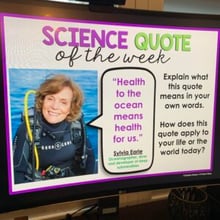Seasons Activities for Middle School Science
The resources below will provide students a comprehensive understanding of seasons. All of the following lessons are also included in the Kesler Science Membership.
The Seasons 5E Lesson includes materials for every "E" phase, including the Seasons Station Lab for Exploration and an interactive PowerPoint with digital INB templates for Explanation.
The lesson also includes introduction materials for Engagement, student-choice project ideas for Elaboration, and assessments for Evaluation.
After completing the Seasons 5E Lesson, students will be able to model and illustrate the reason for day and night and the seasons.
The Seasons Inquiry Lab is a hands-on activity that is differentiated for advanced, on-level, and modified middle school students.
Seasons Rotation: Students will create a model to demonstrate and describe what causes Earth to go through different seasons. Students will also discover the different between rotation and revolution.
Seasons and Daylight: Students will use data to demonstrate how Earth’s rotation causes day and night. Students will also use data to show how Earth revolves around the Sun causing changes in the seasons.
The Seasons Inquiry Lab includes a brief reading passage, comprehension checks, hands-on activities, reflection questions, and a CER conclusion.
The Seasons Sub Plan is a complete lesson that takes students through a warm-up, reading passage, independent activity, extension activities, and an assessment.
The worksheets are designed to make your sub day a breeze for you, your students, and the substitute teacher. They are also perfect for distance learning.
Seasons Classroom Experiences
Create a powerful student experience to help solidify students' understanding about seasons. All of the following experiences are also included in the Kesler Science Membership.
Escape Rooms
The Seasons Escape Room is an immersive experience for your students. It allows them to demonstrate their knowledge of rotation, revolution, seasons, and day & night, in a fun and engaging way.
Students must use what they have learned to model and illustrate how the tilted Earth rotates on its axis, causing day and night, and revolves around the Sun causing changes in seasons, to Develop and use a model of the Earth-Sun-Moon system to describe the cyclic patterns of lunar phases, eclipses of the Sun and Moon, and seasons to complete the escape room.
STEM CHALLENGES
The Project, Pop-up Moon - Paper Engineering the Lunar Cycle STEM Challenge uses the engineering design process to create a paper-engineered model that has moving parts and interactive elements. The model will need to explain the relationship of the Sun, Earth, and Moon during each of the main moon phases.
Students will be using collaborative skills such as brainstorming with their peers and reflecting on their progress during the project.
At the end of the Project, Pop-up Moon - Paper Engineering the Lunar Cycle STEM challenge, students are given an opportunity to share their projects outside of the classroom.
Explories - A Complete NGSS Storyline
Explories are NGSS units that integrate a storyline and project-based learning with Kesler Science Inquiry Labs, Station Labs, and 5E Lessons. The Explories unit below is also included in the Kesler Science Membership .

DARK: An NGSS Unit Study of the Sky
Welcome to DARK. This is an NGSS unit that integrates a storyline and projects with existing Kesler Science inquiry labs, station labs, and 5E Lessons. In this unit, students will join and assist the fictitious Amateur Astronomers’ Conservation Society, exploring the relationships between the Sun, Moon, and Earth, and evaluating changes that will affect our future atmosphere."Think about the sky for a moment. Do you picture a clear blue day with white puffy clouds? Or a nighttime view full of sparkling stars? Have you ever really thought about the importance of our sky?
You're in luck! You've been given a chance to 'expand your horizons.' Your class has been invited to join the Amateur Astronomers’ Conservation Society.
To complete your membership, you will first complete a specialized model of the Sun, Earth, and Moon’s relationship in space. Then, once you are a full member, you will help other members of the society investigate eclipses, reduce nighttime light pollution, and study the effects of atmospheric changes on our environment.
You're about to experience the sky in a whole new way.
Don’t be afraid of the DARK!"
Year-Round Resources
These year-round activities will increase your students' understanding of many middle school science topics. All of these activities are also included in the Kesler Science Membership.
Visual Data & Graphing
You're not alone if your students struggle with understanding graphs, charts, and tables. It's a skill that takes an enormous amount of practice. This resource will help students build a strong foundation in analyzing data and creating their own data visualizations.
Bell Ringers and Warm-Ups
These middle school science bell ringers are an excellent way to engage your students as soon as they walk into your classroom. This comprehensive FULL YEAR resource includes everything you need to start off each science class with an interesting warm-up activity.
Review Board Games
Each game board has been carefully designed to keep students engaged. There are 10 different action spaces on each board and dozens of question cards. All of the actions are related to science concepts and keep the students motivated throughout the game.
Each game is ready to play. Simply print out the board and the cards and let the students enjoy reviewing nine different units.
Essential Questions and Standards
Below are the essential questions and standards associated with the lessons and activities included in the seasons unit. This topic is only one of more than 100 middle school science topics included in the Kesler Science Membership.
-
What causes day and night?
-
What causes the seasons to change?
-
MS ESS1-1 - Develop and use a model of the Earth-Sun-Moon system to describe the cyclic patterns of lunar phases, eclipses of the Sun and Moon, and seasons
-
TEKS Science 8.7 A - Model and illustrate how the tilted Earth rotates on its axis, causing day and night, and revolves around the Sun, causing changes in seasons
Kesler Science Membership
Imagine never having to search for another middle school science lesson again. The membership gives you access to ALL of the Kesler Science products in one place (Yes, including everything above).
Say goodbye to long hours of lesson prep.



